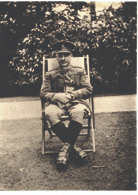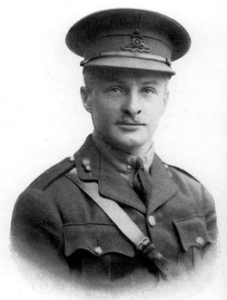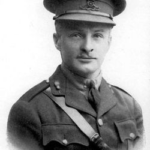

BORN HULL 30/05/1882. ELDEST SON OF OSWALD HILLERNS & HEDWIG LEHMMANN, OF “FAIRWAY” DISSEY, CHESHIRE. HIS GERMAN FATHER WAS A RETIRED MERCHANT. HIS MOTHER WAS DAUGHTER, OF CHIEF JUSTICE, LEHMANN. EDUCATED AT RUGBY SCHOOL, WARWICKSHIRE.
HE WAS EMPLOYED AS AN ARCHITECT, WORKING IN HULL, NEW YORK AND PARIS. RETURNED TO ENGLAND IN 1909 TO WORK IN LONDON. AFTERWARDS STARTED A BUSINESS IN HULL. PASSED THE CANADIAN STATE EXAMINATION WHICH ALLOWED HIM TO WORK AS AN ARCHITECT IN WINNIPEG, CANADA IN 1913.
WHEN WAR BEGAN, HE RETURNED TO HULL TO ENLIST, IN AUGUST 1914. SERVED IN THE ROYAL FIELD ARTILLERY. WAS PROMOTED CAPTAIN IN SEPTEMBER 1915 AND A MAJOR ON 1ST JUNE 1916. HE WAS KILLED BY A SHELL, NEAR ARRAS, ON 14TH APRIL 1917, AGED 35. HE HAD BEEN OUT IN NO MANS LAND LOOKING FOR GUN POSITIONS. HE WAS MENTIONED IN DISPATCHES (MID), ON 18TH MAY 1917., FOR “GALLANT AND DISTINGUISHED SERVICE IN THE FIELD.”
HE WAS UNMARRIED. HE LEFT £1,886 TO HIS FAMILY AT CLIFTON VILLAS, SOUTHFIELD, HESSLE. HIS NAME IS RECORDED ON THE HESSLE ROLL OF HONOUR, ALL SAINTS PARISH CHURCH, THE OTTAWA PEACE TOWER, CANADA AND THE DE RUVIGNY ROLL OF HONOUR, VOLUME 3. HIS DEATH WAS REPORTED IN THE HDM, 27/04/1917
He was born on 30 May 1882, at Hessle, Yorkshire, the eldest son of German-born parents Oswald Carl Englebert, a commission merchant, and Hedwig Ida Hillerns (née Lehmann). After being educated at Rugby School from 1896 to 1900, Hillerns was articled to an architect at Hull.[1] He went on to New York and Paris before returning home in 1909 to work in London.[2] His father, treasurer of the Hull German Lutheran Church, commissioned him to design a new church in 1910.[3]
At the outbreak of war in 1914, Hillerns was living in Winnipeg, where he had passed the Canadian State Examination allowing him to start a business.[2] Hillerns was a pre-war territorial, having been commissioned as a second lieutenant on 21 February 1903, in the 2nd East Riding of Yorkshire Royal Garrison Artillery.[4] He went to the Western Front in September 1915, and in 1916 was in command of “B” Battery, 251st Brigade, albeit without being formally gazetted as major.[1]
On 14 April 1917, Hillerns and three other officers were reconnoitering near Arras in anticipation of their battery being moved to an advanced position when shelling broke out. Hillerns and one of the officers were killed instantly by shrapnel. He had been mentioned in dispatches on 9 April 1917 for ‘gallant and distinguished service in the Field’.[1]
He is buried in Beaurains Road Cemetery. His name is inscribed on the Next of Kin Memorial in Winnipeg, MB.[5]
- ↑ 1.0 1.1 1.2 Memorials of Rugbeians Who Fell in The Great War Volume IV, p. 106.
- ↑ 2.0 2.1 Ancestry.com. UK, De Ruvigny’s Roll of Honour, 1914-1919 [database on-line]. Provo, UT, USA: Ancestry.com Operations, Inc., 2014.
- ↑ Records of the German Lutheran Church in Hull, hullhistorycentre.org.uk. Retrieved 27 August 2015.
- ↑ The London Gazette (27526), p. 1135. 26 February 1903, thegazette.co.uk. Retrieved 27 August 2015.
- ↑ Manitoba Historical Society, Next of Kin Memorial, mhs.mb.ca. Retrieved March 4, 2017.
- MAJOR H. W. O. HILLERNS 2ND NORTHUMBRIAN BRIGADE ROYAL FIELD ARTILLERY, T.F.
HERO WILHELM OSWALD HILLERNS was the elder son of C. E. Oswald Hillerns, Merchant, of Hull, and of Hedwig his wife. He entered the School in 1896 and left in 1900, when he was articled to an Architect. After serving his time in Hull, he followed his profession in New York, Paris, London, and Hull, and finally went to Winnipeg, where he had intended to settle. He had just passed the Canadian State Examination which is required of Architects, when the War broke out. He had been an ardent Officer in the Artillery Volunteers and afterwards in the Territorial Force, and was cabled for on the outbreak of War. He came home immediately and had joined his Battery before the end of August, 1914. In September, 1915, he was ordered to France, where he remained until his death. For about a year he did Major’s work, and organised and commanded a new Battery. On April I4th, 1917, he was engaged with three other Officers in reconnoitring near Warlencourt for an advanced position for the Battery. While engaged in this work they were caught by a sudden burst of shelling by which he and another Officer were killed instantaneously, while the other two were wounded. He was buried in Bauvain Road Cemetery, south of Arras, all the Officers and men of his Battery attending the funeral. Age 34. He was mentioned in Despatches of April gth, 1917, “for gallant and distinguished service in the Field.”
His promotion to the rank of Major was gazetted after his death, to date from June ist, 1916. A brother Officer wrote :— ” The whole Battery down to the roughest driver is greatly moved and feels his loss very deeply. It is no figure of speech to say that he was beloved by every one of us, for not a gentler heart or a better soldier ever fought in this abominable War. I am now the only one left in the Battery who has known him during the last fifteen months of War, but I am not the last who will remember his untiring energy and self-sacrifice, and love
him for his kindly nature and good comradeship.”
